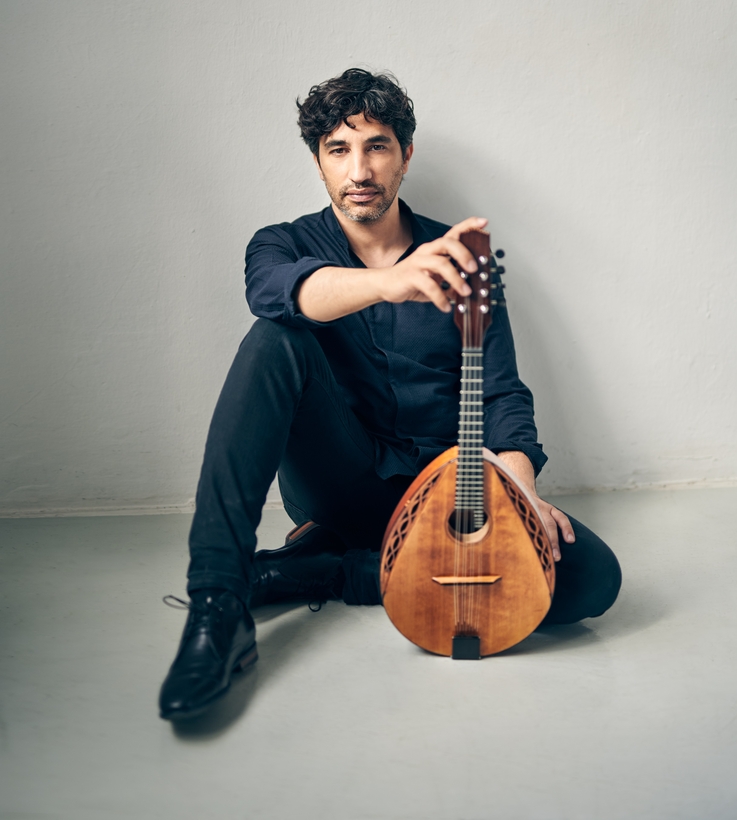For centuries, the mandolin has had its place in the hands of dilettantes more eager to charm than to strike deep. Avi Avital has made it his mission to prove the instrument’s tingling metallic soprano equal to the ambitions of a contemporary virtuoso, and the world has taken note.
Since signing with the Deutsche Grammophon label eight years ago, Avital has released a half dozen albums of Bach and Vivaldi transcriptions on the one hand and novel arrangements of world music on the other. Only with his latest, “Art of the Mandolin,” has he assembled a program dedicated exclusively to music written for the mandolin.
From canonical sources, there isn’t much. Bless Beethoven, who favored a young lady in Prague with a four-and-a-half-minute trifle for mandolin and harpsichord, though he couldn’t be bothered to dignify it with an opus number. Less unexpectedly, the playlist features Baroque diversions from the quills of Vivaldi and Domenico Scarlatti. Scouring the 20th century, Avital came up with chamber pieces for mandolin and other plucked-string instruments by Hans Werner Henze and Paul Ben-Haim. Composers of our time get a hearing with Giovanni Sollima’s whirlwind Prelude for Mandolin Solo and David Bruce’s jangling, all-but-psychedelic plucked-string quintet Death Is a Friend of Ours, two of the 100 or so commissioned works Avital has premiered.
From his home in Berlin, Avital spoke of his journey as a musical maverick.
Matthew Gurewitsch: What are the essential characteristics of the mandolin?
Avi Avital: As with all the plucked-string instruments, we have the sharp attacca when the plectrum, or pick, releases the string, and the very fast decay of the note. Specific to the mandolin are its four double strings. Each pair is tuned the same as one of the four strings of a violin. But there’s no standard shape or sound aesthetic, which gives you an idea how popular and adaptable the instrument has always been in cultures around the world.
M.G.: Is there a Stradivari of mandolin makers?
A.A.: In fact, there are two known Stradivari mandolins, one in a private collection in London, the other in a museum in North Dakota, of all places. Both are much too fragile to string.
M.G.: Tell me about the instrument you play.
A.A.: A mandolin from Arik Kerman, in Israel, has been my voice for 20 years. From the start of my career, we’ve had the same vision: to redefine the mandolin as a top concert instrument, as loud, as rich in sound, range, color, dynamics as other serious instruments. Kerman works with very expensive, seasoned woods from the best dealers in Germany. For many years, he would lie and say he built violas, because he was afraid that otherwise they wouldn’t give him their best wood.
M.G.: Why was this the moment for “Art of the Mandolin”?
A.A.: I wanted to pay tribute and acknowledge the mandolin and its history, to explore how different composers saw the instrument though the centuries. You can tell that the Beethoven was just a little something to show off a young lady’s breeding and beauty. I wish I could find out what’s behind the last piece on the album, Henze’s “Carillon, Récitatif, and Masque.” Someone told me the first movement might originally have been a music cue for a TV show, but I couldn’t confirm that. I think he chose the mandolin, guitar, and harp as a kind of plucked-string equivalent of a classical string quartet. They sound to me almost like a trio of sweet, gentle music boxes playing at the same time but sometimes going off in their own ways, making quite a cacophony.
M.G.: When you commission new pieces, what are you looking for?
A.A.: The first thing I always ask the composer is, “When I say mandolin, what does it say to you? What do you imagine?” You’d be surprised how different the answers are. Sollima’s Prelude is based on the tarantella, a whirling, virtuosic dance of his native Sicily. David Bruce’s Death Is a Friend of Ours has three movements that are full of allusions. I think he’s thinking of the mandolin within the worldwide family of plucked-string instruments.
M.G.: Tell me about the place you come from.
A.A.: I come from Be’er Sheva, in the Negev desert of southern Israel. The population was around 200,000 at the time. It had a university. It had a hospital. It was a small town with a lot of people.
M.G.: And your first teacher was a violinist? How did that happen?
A.A.: His name was Simcha Nathanson, and he was a Holocaust survivor. Musically, he belonged to the great Russian-Jewish romantic school. He played with huge pathos. I’m not exactly sure what happened. When he came to Israel in the 1970s, there was no work for him as a violin professor. Maybe the conservatory had some old mandolins lying around in the cellar, so they asked him to teach mandolin, which he didn’t even know how to play. I’m not sure he had a choice. So he taught himself, inventing an unorthodox technique of his own. But the music he taught was always the traditional violin curriculum. After six years, you play Bach’s Chaconne. After eight years the Saint-Saëns Introduction and Rondo Capriccioso. My later teachers in Jerusalem were violinists, too. And in principle, since the violin and the mandolin are tuned the same, you can play anything on a mandolin that you can play on a violin.
M.G.: But the violin is mostly a bowed instrument, and the mandolin is exclusively a plucked instrument. Does it ever bother you that you can’t play legato?
A.A.: I play legato all the time.
M.G.: I can hear you imagining a legato…
A.A.: I know what you’re saying. But my formation as a musician was based on taking a melody and making it sing.
M.G.: How has the pandemic been treating you? Has it led to new discoveries?
A.A.: On Day 1 of lockdown, our dishwasher broke, and we couldn’t bring anyone in to fix it. So there we were, my wife, my kid, and I, at home all the time, eating three meals a day. I was washing dishes all day and listening to the news from Italy, because the drama factor was the highest. Finally, after two weeks, I took a close look at the back of the dishwasher and found a button labeled “Reset.” I thought, “What if… ?” So I carefully pushed the button, and the machine came back to life. I had to do the same thing. After getting stuck in a tunnel of anxiety, sucking in bad news all day, doing nothing but the dishes, I realized I needed a reset, too. I started to study a lot and play a lot and found a lot of new energy. It’s been very formative! It’s hard to say it was a good thing. But I used the time to accept the new reality.
Matthew Gurewitsch writes about opera and classical music for AIR MAIL. He lives in Hawaii

